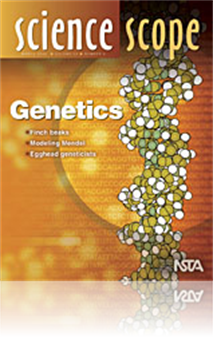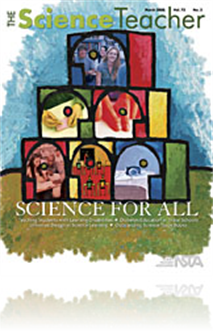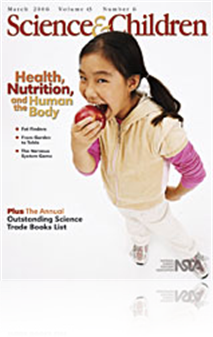All Resources
Journal Article
Outstanding Science Trade Books for Students K-12 (2005 List)
The annual list of Outstanding Science Trade Books for K-12 students was selected by a committee of National Science Teacher Association members. This comprehensive list of selected books were all published in 2005....
Journal Article
Learning Genetics with Paper Pets
By the end of the eighth grade, students are expected to have a basic understanding of the mechanisms of basic genetic inheritance (NRC 1996). However, these concepts can be difficult to teach. To make these concepts easier for students to grasp, hav...
Journal Article
Our Place in the Spongy Universe
Physicist James Trefil once described our universe as "The Spongy Universe," comparing large-scale cosmic structures to the structure of a sponge. Because the sponge is such a good model for the universe, the authors modified this "Spongy Universe" a...
Journal Article
Scope on the Skies: The equinox
With the vernal, or March equinox at hand, now is the perfect time to do some myth-busting with your students by exploring the popular notion that a raw egg will only balance on its end on the equinox. This month’s Scope on the Skies describes this...
Journal Article
The Case Study: Assessment of Case Teaching -- Where Do We Go From Here? Part I
Many undergraduates, especially women and traditionally underrepresented groups, avoid higher-level science and mathematics. Several students who switched from science and mathematics majors in college report "poor teaching by faculty" as a signific...
Journal Article
Universal Design in Science Learning
Universal design provides a framework for science educators to ensure that teaching and learning opportunities are not only standards-based, but inherently flexible, accessible, and usable to accommodate learner diversity--including cultural, socioec...
Journal Article
Science Shorts: Tangling With Hair
You're probably familiar with the fairy tale of Rapunzel and how her prince climbed her golden locks to her tower. In this month's activity, your students will be surprised to find that--though not suitable as a ladder--hair is a lot stronger than t...
Journal Article
Editorial: Explosive Decompression
It is revitalizing to hear and to share new ideas and new methods with fellow colleagues; to engage thoroughly in the community of individuals working side by side to instruct, and yes, to assist in the maturation of students. A few good new ideas a...
Journal Article
Every Day Science Calendar: March 2006
This monthly feature contains facts and challenges for the science explorer. ...
Journal Article
The Finches' Beaks: Introducing Evolutionary Concepts
Many secondary students hold misconceptions about evolution, even after instruction, that are often inconsistent with what is accepted by evolutionary biologists. This activity is based on scientific evidence but many assumptions and alterations have...
Journal Article
Hierarchical Learning Ensembles: Team Building for Undergraduate Scientists and Engineers
This article describes the design and implementation of the Hierarchical Learning Ensemble (HLE) model, a pedagogy that assembles interdisciplinary teams of graduate, undergraduate, and secondary-level students to solve science and engineering proble...
Journal Article
In this section the editor discusses how children are expected to understand how their bodies work as well as how to keep their bodies healthy as aligned with the National Science Education Standards. She gives an overview of the articles in the cur...
Journal Article
Libros de Ciencias en Espanol (2006): A selection of recent science trade books in Spanish
If you have Spanish-speaking students in your science class, you will likely be interested in learning about the recent releases of Spanish trade books for children. From delightful board books and counting books for the very young to comprehensible...
Journal Article
One of the big changes in childhood is the loss of "baby" teeth, beginning around age five. Children often say, "I'm a big kid now. I lost my tooth!" This event is longed for, feared, and celebrated. Tooth care is much on children's (and their pa...
Journal Article
Idea Bank: Wilderness Search and Rescue
As a science teacher, you are probably bombarded with the questions, “Why do we need to know this information?” and “Who uses this information in their jobs?” from your high school students on a daily basis. To answer their questions, incorpo...






